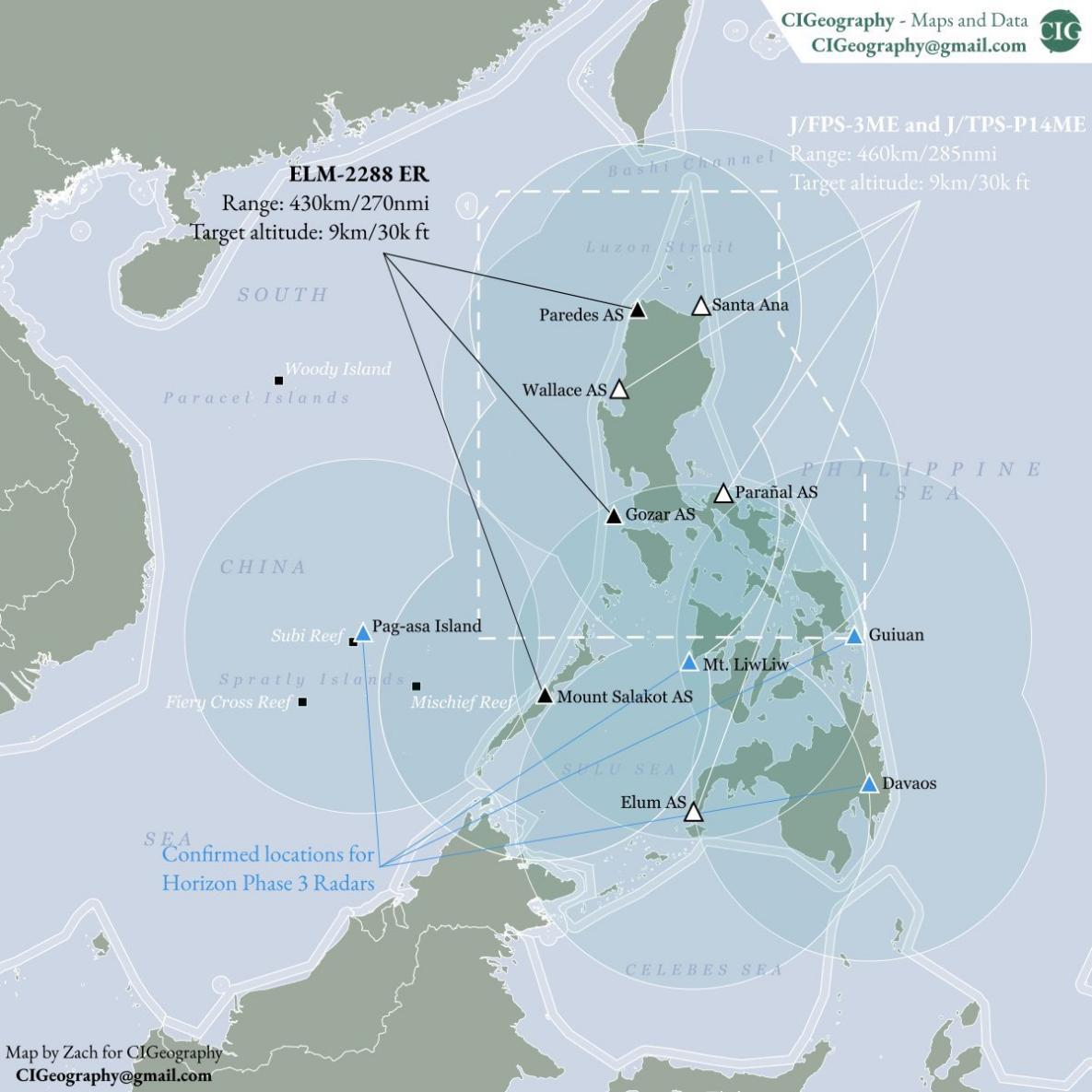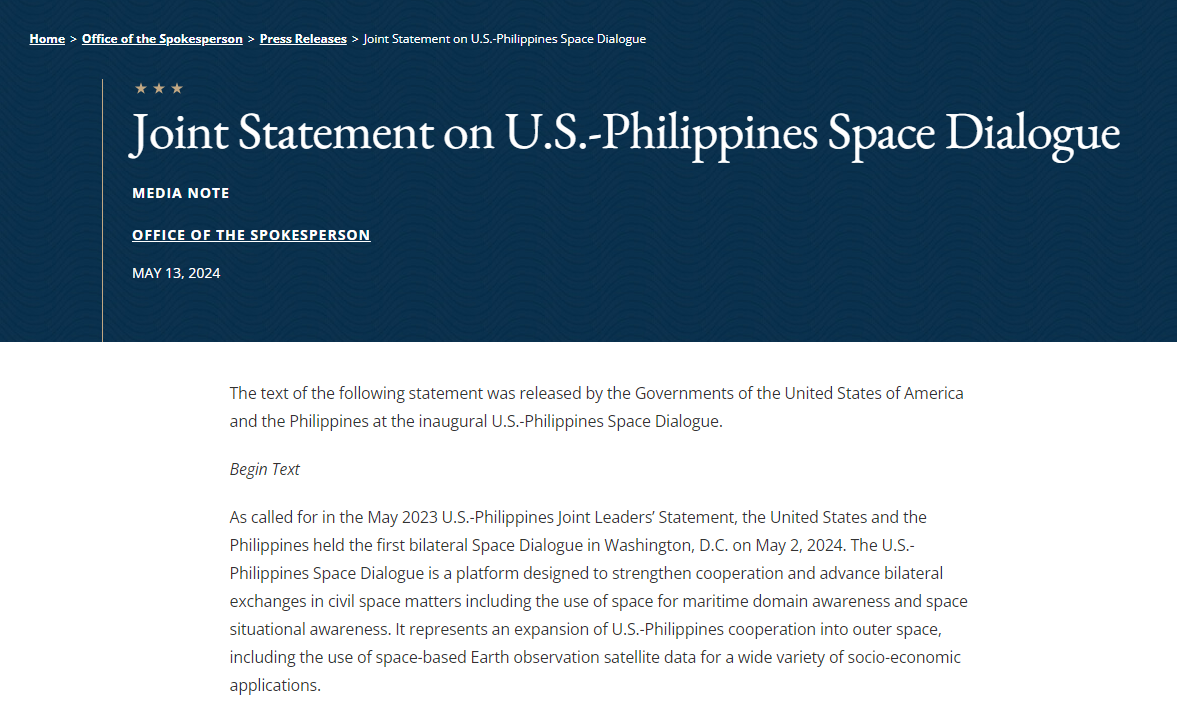Maritime domain awareness (MDA) remains a global challenge. Hindered by technology, budget and experience, the Philippines lags in its awareness capabilities, unable to routinely monitor its archipelagic waters, the nearby Philippine Sea and the so-called “West Philippine Sea”. However, since the administration of Ferdinand Marcos Jr. took office, MDA has become a prominent issue in the country. Starting from February 2023, the Philippine Navy and Western Command have frequently reported the number of Chinese vessels monitored in the waters surrounding the Spratly Islands, attempting to relate the deteriorating situation in the South China Sea to their “threatening presence”. In March 2024, Marcos signed an executive order to enhance maritime security and MDA.[1] On the 77th-anniversary celebration of the Philippine Air Force in July, Marcos stated, “We have increased our MDA by regularly conducting maritime patrol missions [and] monitoring over four hundred unknown tracks within the Philippine Air Defense Identification Zone.” At the operational level, the Philippines has taken various measures to improve its MDA.[2] It has enhanced monitoring technologies through tech programs domestically, and sought collaboration internationally, acquiring and deploying advanced equipment, meanwhile promoting cooperation in relevant technologies and data.
Presently, the Philippines is strengthening its awareness for two main reasons: firstly, to support its “Naming and Shaming” strategy in challenging China in the South China Sea. By exposing Chinese maritime presence and activities internationally, the Philippines aims to garner diplomatic and public opinion pressure on China. Secondly, driven by departmental interests within the Philippine military and police forces, enhancing MDA is a crucial component of Philippine defense modernization and a significant argument for increasing budgets for the military and Coast Guard.
Current Status of the Philippines’ MDA Capabilities
Currently, the main forces involved in the Philippines’ MDA are the Navy, Air Force, Coast Guard and the Bureau of Fisheries and Aquatic Resources (BFAR), with no capabilities of satellite observation and underwater detection yet.
The Philippine Navy comprises around 23,000 personnel, rules 7 naval forces including the Fleet-Marine Ready Force, Northern Luzon, Southern Luzon, Western, Central, Eastern Mindanao and Western Mindanao Naval Forces,[3] and possesses 90 combat ships, 16 auxiliary ships, 33 aircraft (including 8 drones). The total tonnage is approximately 60,000 tons, including 7 inshore patrol craft, 20 patrol boats, 4 maritime patrol aircraft with intelligence, surveillance and reconnaissance (ISR) capabilities, 2 anti-submarine helicopters and 8 reconnaissance drones. The Philippine Coast Guard owns 13 patrol craft, over 30 patrol boats, 1 C-208EX aircraft with minimal surveillance capabilities, 5 ISR-capable RQ-20 drones and 1 Dodeca drone for maritime monitoring. Additionally, BFAR has 13 inshore patrol craft.
The Philippine Air Force comprises approximately 18,000 personnel, rules 3 Air Divisions, 8 Combat/Support Wings,[4] and possesses 25 fighter jets, 3 ISR-capable C-208B reconnaissance aircraft and 16 reconnaissance drones. Before the launch of the Horizon plan in 2012, the Philippines still relied on AN/FPS-20 air defense radars and AN/FPS-6 height-finding radars aided by the US in the last century, with very limited target detection capabilities.[5]
The mentioned forces can only conduct spot-level sensing and detection in some parts of the region, lacking comprehensive domain awareness and systemic observation capabilities. Asia Maritime Transparency Initiative, the US think tank, suggested in an article released in December 2023, “The Philippines faces substantial maritime governance capacity gaps, with shortfalls in maritime domain awareness standing out as a primary concern. Limited surveillance capabilities, inadequate assets including patrol vessels and aircraft, and underdeveloped information-sharing mechanisms constrain the maritime authorities’ comprehensive and real-time understanding of the Philippines’ extensive maritime zones.”[6]
Key Programs Strengthening the Philippines’ Maritime Domain Awareness
All the programs rely heavily on foreign assistance, with Japan being the primary donor. In comparison, despite closer ties between the US and the Philippines, the US military-industrial complex shows little interest in collaboration with the Philippines, likely due to a lack of profitability.
Maritime and air surveillance radars: In 2012, the Philippine government introduced a 15-year modernization program for the armed forces, the Horizon. This program has 3 phases, with Horizon 1 from 2018 to 2019 introducing the Israeli-provided ELM-2288ER 3-D radar deployed at the Gozar, Paredes Air Station in the north of Luzon Island, and the Mt. Salakot Air Station in Palawan.[7] The radar has a maximum detection range of 430 kilometers, partly enhancing the Philippines’ awareness capabilities in the South China Sea and the Bashi Channel direction.

Figure 1. Aerial Surveillance Radar Sites and Coverage Area of the Horizon plan
In August 2020, the Philippine Department of National Defense (DND) signed a procurement agreement with Mitsubishi Electric Corporation to purchase Horizon 2 Air Surveillance Radar System for the Philippine Air Force (PAF), including 3 fixed long-range J/FPS-3ME air surveillance radars and 1 TPS-P14ME medium-range mobile air surveillance radar.[8] Such equipment would endow the PAF with better airspace surveillance and flight control capabilities for air defense tasks, and strengthen security in DND’s areas of concern. In December 2023, the PAF announced that the first set of J/FPS-3ME air surveillance radar systems purchased from Japan had been delivered and installed at Wallace Air Station in San Fernando, La Union, with 2 more sets expected to be delivered within the next 2 years.[9] The J/FPS-3ME radar is a mechanically rotating single-face active phased array radar operating in the L-band with a maximum detection range of 610 kilometers. In April 2024, Japan also delivered a TPS-P14ME medium-range mobile air surveillance radar system to the PAF, which was transported to Camp Aguinaldo in Quezon City. Gilbert Teodoro, the Philippine Secretary of National Defense, claimed that the TPS-P14ME system purchased from Japan would enhance the Philippines’ domain awareness capabilities.[10] The TPS-P14ME is a mobile air surveillance radar with a surveillance range of 400 kilometers, capable of accurately detecting and tracking multiple airborne targets.
In November 2023, former Japanese Prime Minister Fumio Kishida held talks with Philippine President Marcos. Both parties agreed to enhance security cooperation, with Japan providing coastal surveillance radars to the Philippines for the first time under the Official Security Assistance. [11]

Figure 2. Japan-Philippines Summit Meeting Source: Ministry of Foreign Affairs of Japan
Maritime patrol aircraft plan and observation & communication stations: In October 2023, the Philippine Navy Aviation Unit unveiled plans to procure 3 fixed-wing anti-submarine maritime patrol aircraft, set to be operational between 2027 and 2033. Philippine Navy Commander Toribio Adaci expressed a desire to upgrade the coastal surveillance stations scattered across the Philippines’ 7,641 islands, typically equipped with short-range radars and cameras.[12]
Unmanned systems: In October 2024, the Philippine Navy also announced its intention to enhance MDA through the newly established Unmanned Surface Vessel fleet.[13]
Seeking Data Support from countries like the US and Canada Directly
Despite some progress on MDA platforms and programs from extensive international cadging, there is limited substantive progress due to the Philippines’ overall bureaucratic efficiency and budget. In October 2020, Delfin Lorenzana, Philippine Defense Secretary, said that the Horizon 2 would not be completed on time, and the “minimum credible defense” was also hindered by the constrained budget.[14] Even if the Philippines were to implement all planned MDA programs, the integration of these diverse systems from various sources would far exceed its technical and managerial capabilities.
As a result, seeking direct support from Western countries’ data may be the most realistic choice. The US is naturally preferred as external assistance. It is worth noting that despite the US-Philippine alliance and the US emphasizing its solidarity frequently, the US is unlikely to routinely share military intelligence system information and data with the Philippines out of legal, security and strategic considerations. Instead, relevant data is primarily provided through civilian and commercial systems.
Since 2021, the Philippines has been using the SeaVision maritime program led by the US Department of Transportation for free. Currently, the Philippine Coast Guard, Navy, BFAR and the National Coast Watch Center are all utilizing this system. SeaVision is a web-based tool that tracks vessels all day using satellite imagery, transponders and infrared sensors, providing near-real-time and historical information on vessel positions and details (such as owners, operators and port visit histories). According to the Philippines’ side, “Such programs can help monitor and document vessels in the Philippines’ territorial waters and Exclusive Economic Zone, ensure the safety of mariners at sea, monitor and help protect the environment, and help combat illegal, unreported and unregulated fishing.”[15]
In May 2024, the US and the Philippines issued a joint statement on space dialogues, announcing strengthened cooperation in utilizing space for MDA and space domain awareness (SDA). The US State Department revealed considerations to potentially designate the Philippines as the next location for a US Geological Survey Landsat ground station. They also explored expanding cooperation in utilizing space for MDA. In October 2022, the Philippine company Data Lake signed an agreement with SpaceX to become the first commercial Starlink partner in Southeast Asia. In October 2024, Philippine Kabayan party Congressman Ron Salo stated that once the bill he submitted to the House of Representatives in September becomes law, it will allow Starlink to establish and operate telecommunication systems, including building and maintaining ground stations and infrastructure supporting its satellite internet services.[16]

Figure 3 Joint Statement on U.S.-Philippines Space Dialogue
In addition, under the framework of the Indo-Pacific Partnership for Maritime Domain Awareness (IPMDA) involving the US, Japan, India and Australia, the US is coordinating with the others to provide support to the Philippines.
Apart from the US, Canada is increasingly becoming another major source of MDA data for the Philippines. In October 2023, an agreement was signed during the sixth meeting of the Canada-Philippines Joint Commission on Bilateral Cooperation held in Canada, allowing the Philippines’ National Coast Watch Center to use Canada’s Dark Vessel Detection System data for free. Colin Townson, Head of Political Affairs at the Canadian Embassy in the Philippines, stated, “Canada and the Philippines held bilateral talks in Ottawa this week. (They) signed an agreement to deploy Canada’s Dark Vessel Detection program to enhance Philippine MDA.”[17] This satellite system will provide the Philippines with “near-real-time monitoring capability” to help enhance its MDA. In recent maritime disputes between China and the Philippines, the Philippine Coast Guard and Western Command claimed multiple times that they “discovered Chinese vessels turning off their Automatic Identification System (AIS) through this system.”
In MDA, the Philippines heavily relies on external support whether on equipment, platforms, systems or data. Despite acquiring quite a few new equipment, platforms and programs in recent years, a cohesive capability has not formed yet, leading to struggling progress. Given that the Philippines views China as the “primary maritime threat” and engages in maritime disputes, China needs to closely monitor the Philippines’ progress in MDA. As aforementioned, the impact of direct external support in systems and data is more significant than the Philippines’ efforts to build awareness capabilities, making it a trend worth more attention for China. Recently, the sharing of both accurate and misleading data with the Philippines has become an important means for countries like the US to intervene in South China Sea affairs. Furthermore, the Philippines’ general incompetency in verification and identification, they are susceptible to manipulation and exploitation, becoming the vanguards in the US-led maritime cognitive, propaganda and diplomatic warfare against China.

